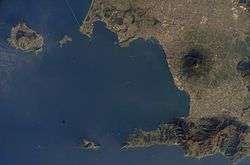Please tell us which country and city you'd like to see the weather in.

Province of Naples
The Province of Naples (Italian: Provincia di Napoli, Napulitano: Pruvincia 'e Nàpule) was a province in the Campania region of southern Italy; since January 2015 has been replaced by the Metropolitan City of Naples.
Demographics
The province of Naples is the most densely populated in Italy. At the 2013 census were all located in the province, as were 10 of the top 15. It has an area of 1,171.13 km², and a total population of about 3.05 million.
Largest communities in the Napoli metropolitan area):
Tourism
The area is particularly fruitful for tourism, both national and international. Pompeii, the excavated Roman city which was destroyed by Mount Vesuvius in 79 AD is among the most popular destinations in all of Italy.
Three islands in the Gulf of Naples are also prominent destinations; Ischia, Procida, part of the Phlegrean Islands, and Capri. Together they are also known as the Campanian Archipelago. On Capri, there is the famous Blue Grotto; inside the grotto the sea seems to be lit from underwater, it is a magnificent blue colour, hence its name.

Naples
Naples (/ˈneɪpəlz/; Italian: Napoli [ˈnaːpoli], Neapolitan: Napule [ˈnɑːpulə]; Latin: Neapolis; Ancient Greek: Νεάπολις, meaning "new city") is the capital of the Italian region Campania and the third-largest municipality in Italy, after Rome and Milan. In 2015, around 975,260 people lived within the city's administrative limits. The Metropolitan City of Naples had a population of 3,115,320. Naples is the 9th-most populous urban area in the European Union with a population of between 3 million and 3.7 million. About 4 million people live in the Naples metropolitan area, one of the largest metropolises on the Mediterranean Sea.
Naples is one of the oldest continuously inhabited cities in the world. Bronze Age Greek settlements were established in the Naples area in the second millennium BC. A larger colony – initially known as Parthenope, Παρθενόπη – developed on the Island of Megaride around the ninth century BC, at the end of the Greek Dark Ages. The city was refounded as Neápolis in the sixth century BC and became a lynchpin of Magna Graecia, playing a key role in the merging of Greek culture into Roman society and eventually becoming a cultural centre of the Roman Republic. Naples remained influential after the fall of the Western Roman Empire, serving as the capital city of the Kingdom of Naples between 1282 and 1816. Thereafter, in union with Sicily, it became the capital of the Two Sicilies until the unification of Italy in 1861. During the Neapolitan War of 1815, Naples strongly promoted Italian unification.
Naples (disambiguation)
Naples is a major city and province in Italy
Naples may also refer to:
Places
Italy
- Naples International Airport, IATA code NAP
- Port of Naples
West Bank
United States
- Naples Historic District, a U.S. historic district in Naples, Florida
- Naples Municipal Airport, IATA code APF
- Naples (village), New York, within the town of Naples

Naples, Texas
Naples is a city in Morris County, Texas, United States. The population was 1,378 at the 2010 census.
Geography
Naples is located at 33°12′11″N 94°40′44″W / 33.20306°N 94.67889°W / 33.20306; -94.67889 (33.202983, -94.679006).
According to the United States Census Bureau, the city has a total area of 2.4 square miles (6.2 km2), of which, 2.4 square miles (6.2 km2) of it is land and 0.04 square miles (0.10 km2) of it is water. The total area is 99.16% land.
Demographics
As of the census of 2000, there were 1,410 people, 625 households, and 388 families residing in the area. The population density was 595.4 people per square mile (229.7/km²). There were 732 housing units at an average density of 309.1 per square mile (119.3/km²). The racial makeup of the city was 64.11% White, 33.83% African American, 0.64% Native American, 0.50% from other races, and 0.92% from two or more races. Hispanic or Latino of any race were 0.57% of the population.
There were 625 households out of which 24.6% had children under the age of 18 living with them, 43.7% were married couples living together, 14.9% had a female householder with no husband present, and 37.8% were non-families. 36.6% of all households were made up of individuals and 19.4% had someone living alone who was 65 years of age or older. The average household size was 2.26 and the average family size was 2.92.
Radio Stations - Provincia di Napoli
SEARCH FOR RADIOS
Podcasts:

Latest News for: province of naples
Terna: authorisation received for works to upgrade the “S. Antimo-Fratta” power line between the provinces of Naples and Caserta (Terna Rete Elettrica Nazionale SpA)
Terna: authorisation procedure begins for upgrading of “Patria - S. Antimo” power line in the province of Naples (Terna Rete Elettrica Nazionale SpA)
Terna, work underway for the connection between Sorrento and Lettere, in the province of Naples (Terna Rete Elettrica Nazionale SpA)
- 1
